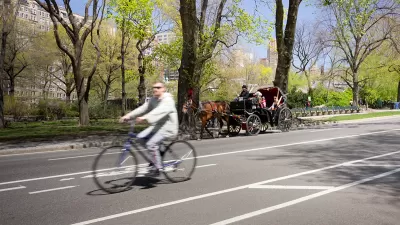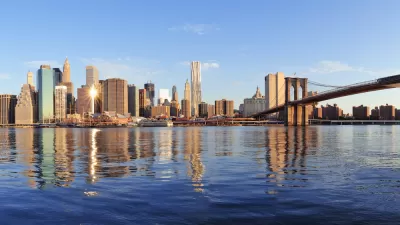Big city mayors (and even some smaller city leaders) are making a big splash! LA’s Antonio Villaraigosa is dealing with crime; Chicago’s Richard Daley is turning that dusty city green; Philadelphia’s John Street has agreed to an important re-thinking of seven miles of highly developable waterfront; Miami’s Manny Diaz is working closely with Donna Shalala, President, University of Miami, to harness anchor-institution strength to downtown development. And Michael Bloomberg became a winner when he took on New York City’s school system. But of equal note is his soon-to-be announced PlaNYC, a strategic vision for 2030.
Big city mayors (and even some smaller city leaders) are making a big splash! LA's Antonio Villaraigosa is dealing with crime; Chicago's Richard Daley is turning that dusty city green; Philadelphia's John Street has agreed to an important re-thinking of seven miles of highly developable waterfront; Miami's Manny Diaz is working closely with Donna Shalala, President, University of Miami, to harness anchor-institution strength to downtown development. And Michael Bloomberg became a winner when he took on New York City's school system. But of equal note is his soon-to-be announced PlaNYC, a strategic vision for 2030.
The 1989 charter revision mandated every mayor to produce a strategic plan. Since that time, two other mayors have come and gone, leaving behind no strategic plan, but that is another story. Bloomberg is doing it right--- although his timing is questionable since he has about 1,000+ days left in his administration. Nonetheless, the effort is commendable and, if handled with wisdom and savvy can leave an important legacy.
Bloomberg is previewing the plan via his impressive Office of Strategic Planning Staff, Rit Aggarwala, head, Rachel Weinberger, borrowed from Penn to work on transportation and others. At first view, the plan is extraordinarily exciting. For the first time in thirty years, mayoral leadership is producing a city-wide vision whose appropriately-chosen themes are entirely on target, message is clear and solutions broad, leaving ample room for local impact once the strategic direction is set, as will happen with this document.
Crafted with input from 20 city agencies and a blue ribbon Advisory Board on Sustainability, PlaNYC focuses on three key issues: accommodating population growth (OpeNYC), fixing aging infrastructure (MaintaiNYC), and addressing environmental issues (GreeNYC. The message is simple, supported by few (take note planners) but potent data and expressed in clear, albeit not very beautiful but dramatic graphics (see www.nyc.gov/planyc2030).
So what is the message? Here it is: The city's population may grow by another million and its jobs rise by 3/4 of a million. Housing is too expensive. (Even today about a 1/3 of renters [65% of all households] pay more than 50% of their income in rent). Movement of people and goods is inefficient, costly and deteriorated (congestion costs $5 billion in lost time, 60% of the subway stations are not in good repair, 3,000 lane-miles of roads need repaving). Sewerage and energy systems are stressed and polluting. (A tenth of an inch of hard rain releases untreated sewage into the waterways to the tune of an annual two billion gallon overflow The city's old 25 power plans use 50% more fossil fuels than new ones-soot levels are 27% higher than national requirements and asthma hospitalizations twice the national average). Residents' access to open space is limited (of the city's 188 neighborhoods, 100 have inadequate playgrounds-more than a ten minute walk).
After all this bad news, PlaNYC offers hope in articulating few goals, attaching numerical targets for some key elements. For example, like London's revised London Plan, it calls for a 30% reduction in global warming emissions, it also envisions 265,000 new housing units, putting the transit and road systems in a state of good repair, cleaning up 1,700 acres of brownfields, adding enough parks to ensure every resident's access with a ten-minute walk and so on.
The key question is what next? With only a couple of years left as mayor, Bloomberg will need to do a few things. He will have to begin to institutionalize the goals in city business-hold his agencies accountable in a myriad of ways to the targets, direct budget expenditures to their implementation. And as planning ad development decisions make their way through the city's highly participatory public processes, he will have to find a way to achieve conformity with the goals. These few demands will require building support based on consensus. Only in this fashion, will this plan have the longevity it needs. And only in this way will this big city mayor's splash have lasting impact.

Alabama: Trump Terminates Settlements for Black Communities Harmed By Raw Sewage
Trump deemed the landmark civil rights agreement “illegal DEI and environmental justice policy.”

Planetizen Federal Action Tracker
A weekly monitor of how Trump’s orders and actions are impacting planners and planning in America.

Why Should We Subsidize Public Transportation?
Many public transit agencies face financial stress due to rising costs, declining fare revenue, and declining subsidies. Transit advocates must provide a strong business case for increasing public transit funding.

Understanding Road Diets
An explainer from Momentum highlights the advantages of reducing vehicle lanes in favor of more bike, transit, and pedestrian infrastructure.

New California Law Regulates Warehouse Pollution
A new law tightens building and emissions regulations for large distribution warehouses to mitigate air pollution and traffic in surrounding communities.

Phoenix Announces Opening Date for Light Rail Extension
The South Central extension will connect South Phoenix to downtown and other major hubs starting on June 7.
Urban Design for Planners 1: Software Tools
This six-course series explores essential urban design concepts using open source software and equips planners with the tools they need to participate fully in the urban design process.
Planning for Universal Design
Learn the tools for implementing Universal Design in planning regulations.
Caltrans
Smith Gee Studio
Institute for Housing and Urban Development Studies (IHS)
City of Grandview
Harvard GSD Executive Education
Toledo-Lucas County Plan Commissions
Salt Lake City
NYU Wagner Graduate School of Public Service






























